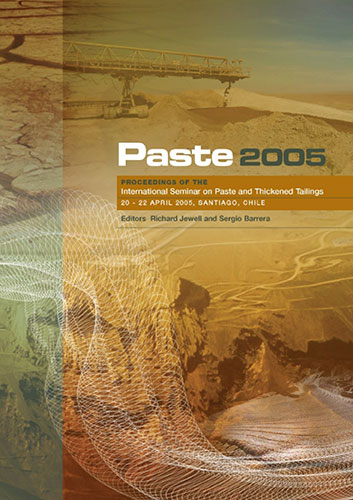Laminar Flow – Possible Pipeline Operating Mode

|
Authors: Shou, G Paper is not available for download Contact Us |
DOI https://doi.org/10.36487/ACG_repo/563_3
Cite As:
Shou, G 2005, 'Laminar Flow – Possible Pipeline Operating Mode', in R Jewell & S Barrera (eds), Paste 2005: Proceedings of the International Seminar on Paste and Thickened Tailings, Australian Centre for Geomechanics, Perth, pp. 45-52, https://doi.org/10.36487/ACG_repo/563_3
Abstract:
Slurry pipeline designers usually state that the operating velocity of a slurry pipeline should be higher than the transition velocity. In other words, laminar flow is not allowed in a slurry pipeline. The major concern is the potential of pipeline plugging. When designing a thickened tailings or paste pipeline, the au- thor found that the operating cost would be prohibitively high if this rule is ap- plied. A literature research and a loop test show that laminar flow is feasible under certain conditions. The transition velocity of a slurry flow can be calculated based on the slurry viscosity, yield stress and pipeline ID. When the operating velocity is lower than the transition velocity, a solids bed may form on the pipeline bottom. The depth of the solids bed and the pipeline effective ID varies depending on the flow rate. This self-adjusting nature of slurry flow in pipeline allows us to operate a pipeline in a wider range and save the capital and operating costs significantly. The potential of pipeline plugging is different from one pipeline system to another. Therefore, it should be evaluated for each individual thickened tailings pipeline. 46 Paste 2005, Santiago, Chile Laminar Flow - Possible Pipeline... Shou, G.
References:
Hanks, R.W., and Dadia, B.H. (1971) Theoretical Analysis Of The Turbulent
Flow Of Non-Newtonian Slurries In Pipes, AIChE Jnl.
Song, T. and Chiew, Y-M. (1997) Settling Characteristics of sediments in moving
Bingham Fluid, J of hyd. Eng, Vol. 123, No. 9, ASCE.
Gillies, R.G., Hill, K.B., McKibben, M.J. and Shook, C.A. (1999) Solids Trans-
port by Laminar Newtonian Flows, J. Powder Technology.
© Copyright 2025, Australian Centre for Geomechanics (ACG), The University of Western Australia. All rights reserved.
View copyright/legal information
Please direct any queries or error reports to repository-acg@uwa.edu.au
View copyright/legal information
Please direct any queries or error reports to repository-acg@uwa.edu.au